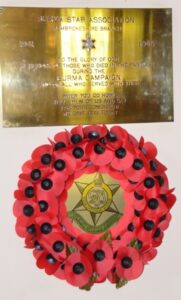St. David’s Church is situated in Prendergast, Haverfordwest. There are several war graves in the attached Churchyard, and inside the Church are brass war memorial plaques, which commemorate the Parishioners who fell during both World Wars. There is also a third memorial which commemorates the local men who fought in Burma, which was erected by the Pembrokeshire branch of the Burma Star Association. The photographs of the plaques were kindly sent in by Dai Phillips.
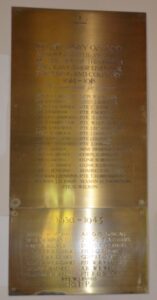
The Great War, 1914-1918
Stanley Thomas Bowen, Sergeant, 11, Welsh Regiment. Stanley was born in 1884, the only son of Alfred Henry Bowen and Hannah Bowen (nee Griffiths), of Prendergast, Haverfordwest. He married Gertrude Mary Clarke on 8 January 1905 and set up home with his new wife at 70, Prendergast, Haverfordwest, where their three children were born. His father died later that year, and his mother moved to Hakin, to work at the Bridge Hotel. Stanley enlisted at Haverfordwest into the 1/4th Battalion, Welsh Regiment, which was attached to 159 Brigade, 53rd (Welsh) Division. The Division moved to the Mediterranean, sailing from Devonport in July 1915 arriving at Mudros by 5 August 1915. From here they moved to Gallipoli, landing on 8 August 1915. Here they immediately faced the chaotic leadership that was to lead to the ultimate failure of the campaign, and spent the next few days in isolated pockets, fighting against a Turkish counterattack. Stanley was killed in action here on 10 August 1915, aged 29. He has no known grave, and so is commemorated on the Helles Memorial, Gallipoli. Gertrude later remarried, and emigrated to Erindale, Ontario, Canada.
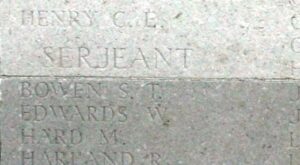
John Henry Brown, Private, 34740, Royal Warwickshire Regiment. John was born at Haverfordwest in 1898, the youngest child, and only son, of John and Catherine Brown. He lived with his mother at 13, Gracechurch Terrace, Milford following his father’s death in 1912, and enlisted there into the army. He was first posted to the Cheshire Regiment, with the service number 306051, before being posted to the 1/6th Battalion, Royal Warwickshire Regiment. The battalion was part of 143 Brigade, 48th Division, and in November 1917 sailed for Italy, where it remained for the duration of the war, taking part in actions on the Asiago Plateau- the Battle of Asiago and the Advance from Asiago, with the infantry of 143 Brigade becoming the first British soldiers to enter the home territory of the Central Powers. John died of pneumonia at the 24th Casualty Clearing Station, Italy on 20 November 1918, aged 20. He is buried in Montecchio Precalcino Communal Cemetery Extension, Italy. His oldest sister, Edith Ellen Allen (nee Brown), was my great grandmother.
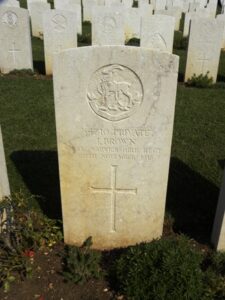
Robert Lloyd Davies, Lieutenant, Royal Engineers. Robert was the eldest son of J.M. Lloyd Davies and Maud Davies of ‘Glanafon’, Haverfordwest. He was commissioned into the Royal Engineers, and served with the 129th Field Company, attached to the 24th Division. They moved to France during August, 1915 and marched to positions near Loos, where they took up reserve positions for the main Battle of Loos. The Division were sent into battle on 26 September 1915 at Loos and suffered terrible casualties due to not being properly trained for battle, and were pulled from the line until the following year. In 1916 they took part in the Battle of the Somme, and fought at Delville Wood and Guillemont, before moving north of Arras in early 1917. In April and May 1917 they fought at the Battle of Vimy, alongside the Canadian Corps. Robert was killed in action here on 12 April 1917. He was 29 years old, and is buried at Aix-Noulette Communal Cemetery Extension, France.
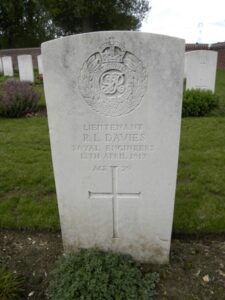
John Lloyd Farrow, Private, 408, Welsh Regiment. John was the son of John and Susannah Agnis Farrow, of 8, Old Bridge, Haverfordwest, and he enlisted there into the 1/4th Battalion, the Welsh Regiment. The Battalion was attached to 159 Brigade, 53rd (Welsh) Division, which moved to the Mediterranean, sailing from Devonport in July 1915 and arriving at Mudros by 5 August 1915. From here they moved to Gallipoli, landing on 8 August 1915. Here they immediately faced the chaotic leadership that was to lead to the ultimate failure of the campaign, and spent the next few days in isolated pockets, fighting against a Turkish counter-attack. The Division remained here throughout the coming months, and suffered severe losses in manpower strength during the great November 1915 blizzard on Gallipoli, when its total strength was reduced to less than that of a full-strength Brigade. John was killed in action during this terrible period, on 26 November 1915. He was 30 years old, and is buried at Lala Baba Cemetery, Gallipoli.
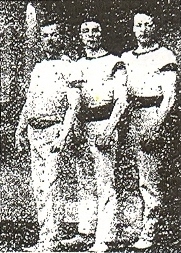
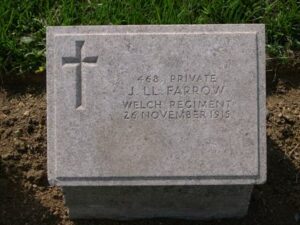
John Henry Gambold, Private, 16586, North Staffordshire Regiment. John was born on 14 November 1894, the son of John and Mary Ann Gambold, of Colby Scott, Prendergast, Haverfordwest. He enlisted there into the Welsh Regiment, with the Regimental Number 11828, but was transferred into the 7th Battalion, North Staffordshire Regiment, which was attached to 39 Brigade, 13th (Western) Division. Towards the end of February the entire Division concentrated at Blackdown in Hampshire. On 7 June 1915, orders were received to prepare to move to the Mediterranean. On 13 June 1915 the Division left port, and moved to Alexandria. By 4 July, all units had moved to Mudros, preparatory for landing on Gallipoli. Between 6 and 16 July, 1915 the Division landed on Cape Helles and relieved the 29th Division. They left and returned to Mudros at the end of the month, and the entire Division landed at ANZAC Cove between 3 and 5 August 1915, taking part in the Battle of Sari Bair, where John was killed in action on 6 August 1915 aged just 21. He has no known grave, and is commemorated on the Helles Memorial, Gallipoli.
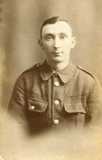
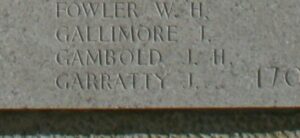
Frederick Hardaker, Private, 57424, Suffolk Regiment. Frederick was the son of Frederick and Frances Hardaker, of 135, Prendergast, Haverfordwest. He had enlisted at Haverfordwest into the Lancashire Fusiliers, with the Regimental Number 50879, but had been transferred into the 12th Battalion, Suffolk Regiment, which was attached to 43 Brigade, 14th (Light) Division. The Division had been in France since early in 1915, and had fought there throughout the war, seeing terrible fighting on the Somme in 1916, at Passchendaele and Cambrai in 1917, and throughout 1918. It’s final actions were during the advance to victory in Flanders during the end of the year. Frederick died of sickness (probably influenza) at home on 3 May 1919. He was just 19 years old, and is buried at Prendergast Cemetery, Haverfordwest.
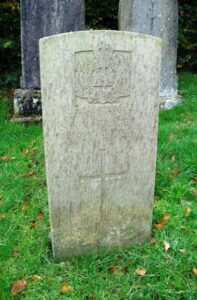
John Harries, Private, 203540, Welsh Regiment. John was born in Haverfordwest in 1887, and resided at 5, Lower March, Haverfordwest. He enlisted there into the 4th Battalion, Welsh Regiment, and was posted to France, joining the 9th Battalion, which was attached to 58 Brigade, 19th (Western) Division. The Division assembled around Bulford during September 1914. Divisional training was completed near Tidworth, from March 1915, and the Division crossed to France during July 1915, moving to positions near Loos. The Division fought during the opening attack of the Battle of Loos, and then moved to the Somme, where they took part in the second wave of the attack on Ovillers-La Boiselle on 1 July 1916, capturing the village at heavy cost, and fought through the Somme Battles of Pozieres and the Ancre in 1916. They then moved North to Ypres, taking part in the Battle of Messines, then fought during the Third Battle of Ypres. In 1918 they were caught up in the German Spring Offensive near St. Quentin, where they suffered terrible casualties, and fought at the Battle of Bapaume. They moved to Ypres, but were caught up in the German attack at Messines. After suffering terribly again, they moved South to the quieter French sector to rebuild, but were caught up in the German offensive on the Aisne, and saw heavy fighting yet again. John must have been wounded during the early part of the year, during the German Offensive. He was evacuated home for treatment, but sadly died of wounds at the Queens Hospital Chislehurst, Kent on 6 August 1918, aged 31. He is buried at St. Thomas A Becket Churchyard, Haverfordwest.
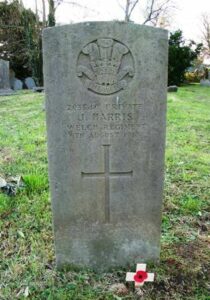
Robert Stanley Higgs, Private, 30805, Welsh Regiment. Stanley was the son of William and Maud Higgs, of Milford Haven. In 1909 he married Christina Thomson, of High Road, Whetstone, London, and moved to Haverfordwest where he fathered three children with her. His wife worked as a photographer in the town. Stanley had served with the 1st Volunteer Company, Welsh Regiment during the Boer War and was still a reservist when he re-enlisted at Haverfordwest on 1 March 1915 into the Welsh Regiment. On 17 March he was posted to France, joining the 1st Battalion, Welsh Regiment, which was attached to 84 Brigade, 28th Division. The Division had formed in England between December 1914 and January 1915 from regular units returning from India, Singapore and Egypt. During January 1915 it moved to France, landing at Le Havre and moved to the Western Front, where it saw its first major action during the Second Battle of Ypres. Within days of landing in France Stanley had joined the 1st Welsh at Ypres, but within a month of arriving at the front he was wounded in action and died of wounds that same day, on 21 April 1915. He was 38 years old, and is buried in Bedford House Cemetery, Belgium. He is incorrectly shown on the memorial as C. E. Higgs.
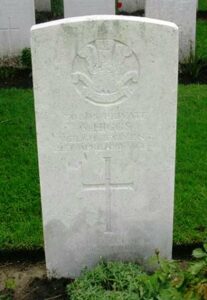
James Henry Hurlow, Private, 54160, Welsh Regiment. James was born at Prendergast in 1897, the son of Elizabeth Hurlow, of Stephens Yard Hill, Haverfordwest. He enlisted at Swansea into the 13th Battalion, Welsh Regiment. The battalion had been raised at Cardiff on 23 October 1914, and moved to Rhyl as part of 129 Brigade, 43rd Division. On 29 April 1915 the formation became 114 Brigade, 38th Division, and in August 1915 moved to Winchester. During December 1915 the Division landed at Havre, and spent their first winter in the trenches near Armentieres. In June they marched south to the Somme, where they famously captured Mametz Wood. The Division suffered terrible casualties at Mametz, and were taken out of the line, and moved to Ypres to rebuild. Here they fought at the Battle of Pilckem Ridge, which is where James was killed in action on 31 July 1917, aged 20. He is buried at No Man’s Cot Cemetery, Belgium.
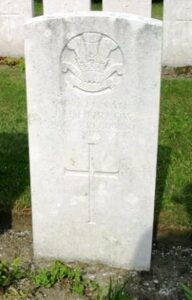
Charles Henry James, Private, 201562, Welsh Regiment. Charles was the son of Henry and Julia James, of 30, Prendergast Hill, Haverfordwest. He had served with the 1/4th Battalion, Welsh Regiment, which was the local Territorial Battalion, attached to 159 Brigade, 53rd (Welsh) Division. The Division had fought at Gallipoli in 1915, and on 11 December 1915 the Division was evacuated to Mudros, and by 23 December 1915 were moved to Egypt. They remained on the Suez Canal Defences for the next twelve months, where it took part in operations against the Sultan of Darfur, and in March 1917 took part in the advance into Palestine, where they remained for the duration of the war, fighting at the Battles of Gaza, and successfully capturing Jerusalem. Charles died at home as a result of his wartime service on 10 January 1919. He was 21 years old and is buried at Haverfordwest (Prendergast) Cemetery.
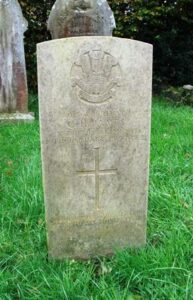
Edwin James, Private, 241468, Welsh Regiment. Edwin was the son of James Watkin James and Florence James, of 98, Prendergast, Haverfordwest. He enlisted at Mountain Ash into the 1/5th Battalion, Welsh Regiment. The Battalion formed on 4 August 1914 at Pontypridd, as part of South Wales Brigade, Army Troops. In November 1914 the Brigade moved to Tunbridge Wells, and in February 1915 to Scotland on Forth and Tay Defences. They joined 159 Brigade, 53rd Division at Bedford, and then on 19 July 1915 sailed from Devonport for Mudros, arriving on 5 August. From here the Division moved to Gallipoli, and on 8 August 1915 landed at Suvla Bay. Here they immediately faced the chaotic leadership that was to lead to the ultimate failure of the campaign, and spent the next few days in isolated pockets, fighting against a Turkish counter-attack during the Battle of Sari Bair, and then at the Attack on Scimitar Hill. The Division remained here throughout the coming months, and suffered severe losses in manpower strength during the great November 1915 blizzard on Gallipoli, when its total strength was reduced to less than that of a full-strength Brigade. On 11 December 1915 the Division was evacuated to Mudros, and by 23 December 1915 was moved to Egypt. They remained on the Suez Canal Defences for the next twelve months, and in early 1917 moved into Palestine, and saw their first action here at the Battle of Gaza. Edwin was killed in action here on 26 March 1917, aged just 21. He has no known grave, and so is commemorated on the Jerusalem Memorial, Israel.
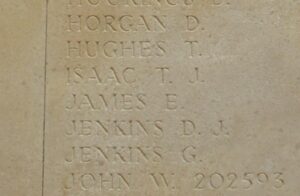
George James, Private, 2722, Welsh Guards. George was born in 1895, the son of George and Ellen James, of 13, Prospect Place, Haverfordwest, and enlisted there into the 1st Battalion, Welsh Guards. The Battalion was attached to the 3rd Guards Brigade, Guards Division. This Division has the distinction of being formed in France in August 1915, of the various Guards units that had been with other Divisions. It remained on the Western Front throughout the war and saw its first major action during the Battle of Loos on 25 September 1915, remaining in the area during the coming months, where they also fought in the subsequent Action of Hohenzollern Redoubt. In July 1916 the Division moved to the Somme, where they fought at the Battle of Flers-Courcelette, and then at the Battle of Morval, capturing Lesboeufs Village. They remained here for the winter, and it was here that George was killed in action on 7 March 1917, aged 22. He is buried at Sailly-Saillisel British Cemetery, France.
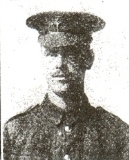
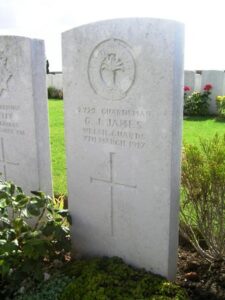
James George James, Lance Corporal, 1847, Welsh Guards. James was the son of Mary Ann James, of 37, Shilo Road, Cartlett, Haverfordwest. He enlisted at Haverfordwest into the 1st Battalion, Welsh Guards. They were attached to the 3rd Guards Brigade, Guards Division. The Battalion saw its first major action during the Battle of Loos on 25 September 1915, remaining in the area during the coming months. In July 1916 the Division moved to the Somme, where they fought at Flers-Courcelette, and at Morval, capturing Lesboeufs Village. They remained here for the winter, and in March 1917 took part in the advance caused by the German Retreat to the Hindenburg Line. Later that year they moved north to Ypres, where they fought at Pilkem Ridge, the Menin Road, Poelcapelle and Passchendaele. November saw them move south again, where they took part in the Battle of Cambrai. They remained in the area over the final winter of the war, and were stationed near Gouzeaucourt when the German Spring Offensive hit the area on 21 March 1918, and fought a bloody rearguard action over the coming days. After this, the German Offensive petered out on the Somme, and on 8 August 1918 a Battle around Villers Brettoneux dealt the Germans a deadly blow. On 21 August the British launched an attack on the Somme, and the Guards Division took part in the great offensive, pushing towards the Hindenburg Line. Once the Hindenburg Line had been broken, the Allies swept eastwards over territory that had been occupied by the Germans for four long years. The Guards fought at Cambrai, the Selle, and the Sambre towards the end of the war. James survived the war but sadly became one of the many casualties of the influenza epidemic that swept Europe at the end of the war. He died at Hospital on 13 December 1918, aged 26, and is buried at Ste. Marie Cemetery, Le Havre, France.
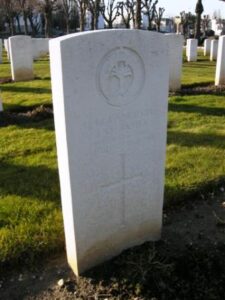
Thomas George James, Private, 200212, Welsh Regiment. Thomas was the son of William and Emily Ann James, of 65, Prendergast, Haverfordwest. It is thought that he lived in Clynderwen prior to the War, and enlisted back at Haverfordwest into the 1/4th Battalion, Welsh Regiment. They formed part of 159 Brigade, 53rd (Welsh) Division, and during July 1915 they sailed from Devonport for Egypt. They were then sent to Gallipoli, landing on 9 August 1915, and stayed on the Peninsula until the withdrawal in December that year, suffering heavy casualties. The Division were back in Egypt by 23 December 1915 and fought in the Palestinian Campaign against the Turkish Empire. It was during the First Battle of Gaza that Thomas was killed in action on 27 March 1917, aged 23. He is buried at Deir El Belah War Cemetery, Israel.
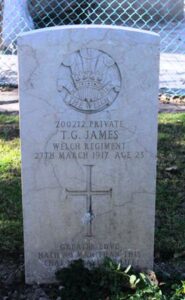
George Edward Jenkins, Private, 56521, Welsh Regiment. George was born in 1895, the son of William and Mary Ann Jenkins, of 20 Prospect Place, Haverfordwest. He enlisted at Haverfordwest on 23 February 1916 into the Welsh Regiment, and was initially posted to the 7th (Cyclist) Battalion, Welsh Regiment. On 26 July 1916 George landed in France, and was posted to the 16th (Cardiff) Battalion, Welsh Regiment, which was attached to 115 Brigade, 38th (Welsh) Division. The Division had just moved from the Somme, where it had taken a mauling during its famous capture of Mametz Wood. Within weeks the division moved to positions at Ypres, alongside the Yser Canal at Boesinghe. It remained here for over twelve months, and on 3 July 1917 fought at the Battle of Pilckem Ridge, and ensuing Battle of Langemarck. George was killed in action at Langemarck when the 16th Welsh were annihilated by an artillery bombardment on 27 August 1917. He was 23 years old, and is commemorated on the Tyne Cot Memorial, Belgium.
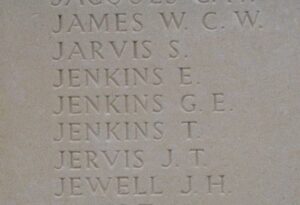
John Jenkins, Stoker, 341736, Royal Navy. John was born at Haverfordwest on 27 March 1877, the son of David and Sarah Jenkins. He had worked as a boilerman at Pontardulais prior to the war, and lived with his wife, Mary Jenkins, at Glanyrafon Road, Pontardulais. John served with the Royal Navy aboard H.M.S. Ariadne. HMS Ariadne was a ship of the Diadem-class of protected cruiser in the Royal Navy. She had been built by J&G Thompson of Clydebank and launched on 22 April 1898. In March 1913 she was converted to a stokers’ training ship and in 1917 was converted to a minelayer and assigned to the Nore Command. She was torpedoed and sunk off Beachy Head by UC-65 on 26 July 1917. John was one of the men killed when the Ariadne went down. He was 39 years old. His body was washed ashore, and so John was brought home to be buried at Rhydgoch Cemetery, Pembrokeshire.
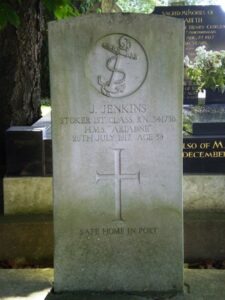
James Henry John, Rifleman, S/1027, Rifle Brigade. James was the son of James and Mary Ann John, of 1, Prospect Place, Haverfordwest. He enlisted at Barry on 4 September 1914 into the Rifle Brigade, and after raining at Winchester was posted to the 11th Battalion, Rifle Brigade, which was attached to 59 Brigade, 20th (Light) Division. On 26 July 1915 the Division completed concentration in the Saint-Omer area, all units having crossed to France during the preceding few days. Early trench familiarisation and training took place in the Fleurbaix area. When the Battle of Loos was launched on 25 September 1915 the Division fought a diversionary attack towards Fromelles. Later that year they moved north, and fought at the Battle of Mount Sorrel alongside the Canadian Corps. Over the winter of 1915/16, the Division remained in positions south of Ypres, and fought at the Battle of Mount Sorrel in June, alongside the Canadian Corps. They then fought through the Somme Offensive, at the Battles of Delville Wood, and Guillemont. John was killed during this period, on 27 August 1916. He was 25 years old, and is buried at Péronne Road Cemetery, Maricourt, France. Many thanks to Philip Slade for the photo of Jim.
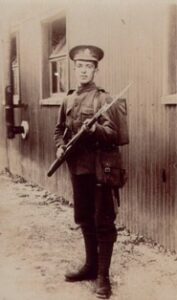
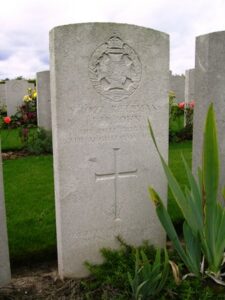
Clement Daniel Jones, Private, G/29321, Middlesex Regiment. Clement was born at Haverfordwest in 1887, the son of George and Mary Jones. He worked as a Draper prior to the war, for Messrs J. Barnes Co. Ltd, 191 and 217 Finchley Rd, Hampstead, and enlisted there into the 21st Battalion, Middlesex Regiment. The Battalion was raised in Islington by the Mayor and Borough on 18 May 1915, and in July 1915 joined 118 Brigade, 39th Division. Taken over by the War Office in August, they moved in October 1915 to Aldershot, then in February 1916 to Witley, where the Battalion moved to 121 Brigade, 40th (Bantam) Division. During June 1916 the Division landed in France, and moved to the front near Loos. Late in 1916 they moved south to the Somme, and fought at the Battle of the Ancre, and remained in the area over the winter. In March 1917 the Germans withdrew to their shortened line, called the Hindenburg Line, and the 40th Division was one of the Divisions that followed the withdrawal. Later in the year they took part in the Battle of Cambrai, playing an important role in the attack on Bourlon Wood. Clement was wounded at Cambrai, and died of wounds on 24 November 1917. He was buried on the battlefield, but his grave must have been lost over the coming few months of fighting in the area, as he is commemorated on the Cambrai Memorial, Louverval, France. His brothers, Peter McKenzie Jones and John Daniel Jones, also fell.
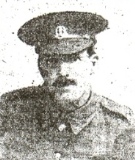
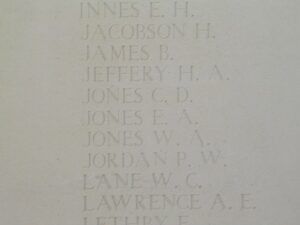
John Daniel Jones, Lieutenant, Royal Field Artillery. John was born in 1871, the son of George and Mary Jones, of Haverfordwest. His wife, Mrs A. M. Jones, resided at 53, Charlton Road, Blackheath, Kent. John was a long serving soldier, and had completed 28 years service by the time war erupted, and landed in France on 19 August 1914 as a Battery Sergeant Major with the 28th Brigade, Royal Field Artillery. John would have taken part in the epic retreat from Mons to the Marne, and on 3 November 1914 was commissioned as a Lieutenant. He served on the Western Front throughout several major battles thereafter, taking part in First and Second Ypres. John was wounded at the beginning of 1916, and evacuated to the Base Hospital at Le Havre, where he sadly died of his wounds on 21 February 1916, aged 45. John is buried there, at Ste. Marie Cemetery, Le Havre, France. His brothers, Peter McKenzie Jones and Clement Daniel Jones, also fell.
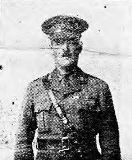
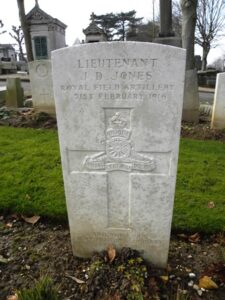
Peter McKenzie Jones, Private, 122194, Machine Gun Corps. Peter was the son of George and Mary Jones. He was a native of Haverfordwest, but the family had moved to London prior to the war, living at Paddington. Peter enlisted at Woolwich into the Army Ordnance Corps, with the Regimental Number 029162, but was later transferred into the 35th Battalion, Machine Gun Corps, which was attached to the 35th Division. The Division had moved to France in late January and early February 1916. It saw its first major action during the Battle of the Somme, at the Battle of Albert. After a spell out of the line, rebuilding, the Division followed the German Retreat to the Hindenburg Line in March 1917. Later in the year they moved north to Ypres, and fought at the Second Battle of Passchendaele. By Spring of 1918 they were back on the Somme, and fought at the First Battle of Bapaume, during the German Offensive. They were then moved back north, and fought later in the year at the Battle of Ypres, and then the Battle of Courtrai, and the subsequent Action of Tieghem. Peter was wounded during Fourth Ypres, and sadly died of his wounds at the Casualty Clearing Station west of Ypres, known as Remy Sidings, on 16 October 1918. He was 30 years old, and is buried there, at Lijssenthoek Military Cemetery, Belgium. Peter is shown as Welsh Regiment on the Memorial. His brothers John Daniel Jones and Clement Daniel Jones also fell.
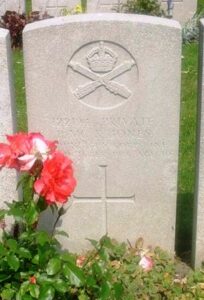
William Ellis Jones, Private, 54167, Welsh Regiment. William was born in Haverfordwest in 1879, and was a printer prior to the war, residing with his wife Edith Ann Jones at 170, Cardigan Road, Haverfordwest. He enlisted at Haverfordwest into the army, and was posted to France sometime in 1917, where he joined the 13th Battalion, Welsh Regiment, which had been on the Western Front since December 1915, attached to 114 Brigade, 38th (Welsh) Division. The Division had captured Mametz Wood during July 1916, and had moved via Hébuterne to Boesinghe, to rebuild in a quieter sector. During the months leading to the launching of the Third Battle of Ypres, the division toiled hard on improving its trenches and carrying out trench raids to plot the location of the enemy defences. On 21 July 1917, ten days before the launching of the offensive, a working part from the 13th Welsh came under artillery fire in Elverdinghe on 21 July 1917, killing eleven men and wounding eleven more. William was 38 years old when he was killed that day and is buried in Bard Cottage Cemetery, Belgium.
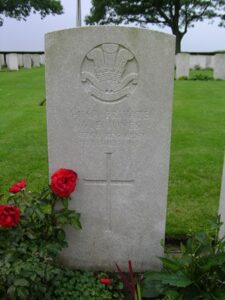
David Rees Lewis, Private, 53981, Welsh Regiment. David was the son of John Lewis, of 60, City Road, Haverfordwest. He married Sarah Alice Owens in 1912, of 137, Back Lane, Prendergast, Haverfordwest. David enlisted at Haverfordwest into the Welsh Regiment, and was posted to the 15th Battalion, Welsh Regiment, which was the Carmarthen Pals battalion, attached to 114 Brigade, 38th (Welsh) Division. The Division had landed in France during December 1915 and had spent their first winter in the trenches near Armentieres. In June they marched south to the Somme, where they took part in the famous capture of Mametz Wood. David probably joined the battalion after it had moved to Boesinghe, north of Ypres, in August 1916. Here they fought at the Battle of Pilckem Ridge, and the Battle of Langemarck. They then moved to Armentieres, where they remained from September 1917 until March 1918 when the German Spring Offensive was launched. The British had been over-run on the Somme, and so in April the Division was moved South, taking up positions North of Albert, from where they weathered the storm of the coming months. On 10 May 1918 the 15th Welsh were ordered to assault the German lines inside Aveluy Wood, and were to be supported by a creeping artillery barrage. Sadly due to an error in range calculations, the shellfire fell short, and created havoc amongst the 15th Welsh. David was one of many men killed that day. He was 24 years old and is buried at Martinsart British Cemetery, France.
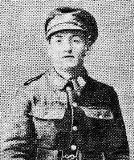
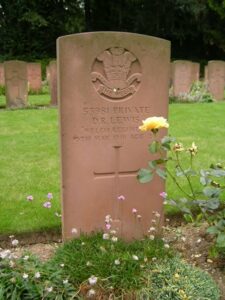
William Alfred Peter Llewellyn, Rifleman, 1950, London Regiment. William was the son of John and Alice Llewellyn, of Haverfordwest. He was a schoolteacher in London prior to the war, and married Amy Elizabeth Treadgold in 1910. The couple resided at 6, Hillmarton Road, Holloway, London. William enlisted at London into the 1/5th Battalion (London Rifle Brigade), London Regiment, which was attached to 169 Brigade, 56th (London) Division. The Division fought its first major action at the diversionary attack on Gommecourt, on the opening day of the Battle of the Somme, on 1 July 1916. William was killed in action this day. He was 39 years old, and is commemorated on the Thiepval Memorial, France.
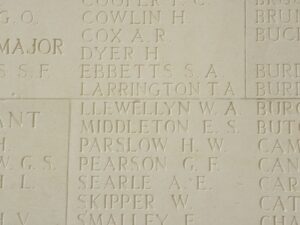
John Harold Merriman, Private, 200089, Welsh Regiment. John was born in Haverfordwest on 30 November 1897, the son of William and Jane Merriman, of 42, Prendergast Hill. He had worked at the GWR Station at Whitland prior to the war, and enlisted back at Haverfordwest into the 1/4th Battalion, Welsh Regiment. The Battalion was attached to 159 Brigade, 53rd (Welsh) Division, and moved to the Mediterranean, sailing from Devonport in July 1915, and arrived at Mudros by 5 August 1915. From here they moved to Gallipoli, landing on 8 August 1915. Here they immediately faced the chaotic leadership that was to lead to the ultimate failure of the campaign, and spent the next few days in isolated pockets, fighting against a Turkish counter-attack during the Battle of Sari Bair, and then at the Attack on Scimitar Hill. John was killed in action on his second day at Gallipoli, on 10 August 1915, aged 17. He has no known grave, and is commemorated on the Helles Memorial, Gallipoli.
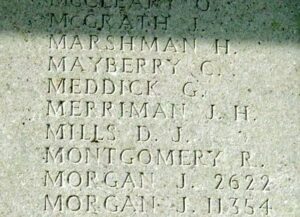
James Morgan, Private, 201447, Welsh Regiment. James was the son of William and Maria Morgan, of 128, Prendergast, Haverfordwest. He was another of the many young men of Haverfordwest who joined the local Battalion, the 1/4th Battalion, Welsh Regiment, which was attached to 159 Brigade, 53rd (Welsh) Division. The 53rd Division moved to the Mediterranean, sailing from Devonport in July 1915 arriving at Mudros by 5 August 1915. From here they moved to Gallipoli, landing on 8 August 1915. Here they immediately faced the chaotic leadership that was to lead to the ultimate failure of the campaign, and spent the next few days in isolated pockets, fighting against a Turkish counter-attack during the Battle of Sari Bair, and then at the Attack on Scimitar Hill. The Division remained here throughout the coming months, and suffered severe losses in manpower strength during the great November 1915 blizzard on Gallipoli, when its total strength was reduced to less than that of a full-strength Brigade. On 11 December 1915 the Division was evacuated to Mudros, and by 23 December 1915 were moved to Egypt. They remained on the Suez Canal Defences for the next twelve months, and in early 1917 moved into Palestine, where they remained for the duration of the war, fighting at the Battles of Gaza, and successfully capturing Jerusalem. James was killed in action during the First Battle of Gaza, on 26 March 1917, aged 36. He has no known grave, and is commemorated on the Jerusalem Memorial, Israel.
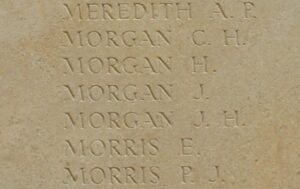
James Oliver, Private, 200189, Welsh Regiment. James was born on 1 March 1889, the son of John and Margaret Oliver, of 18, Spring Gardens, Haverfordwest. James was educated at Haverfordwest, and worked there as a Compositor prior to the war. When war was declared in August 1914 James enlisted at Haverfordwest into the 1/4th Battalion, Welsh Regiment, which was attached to 159 Brigade, 53rd (Welsh) Division. Just after enlisting, James married Frances Charlotte Hale Davies, daughter of Richard Davies, of 26, Prendergast Hill, Haverfordwest. The Division then moved to the Mediterranean, sailing from Devonport in July 1915 and arriving at Mudros by 5 August 1915. From here they moved to Gallipoli, landing on 9 August. Here they immediately faced the chaotic leadership that was to lead to the ultimate failure of the campaign, and spent the next few days in isolated pockets, fighting against a Turkish counter-attack. The Division remained here throughout the coming months, and suffered severe losses in manpower strength during the great November 1915 blizzard on Gallipoli, when its total strength was reduced to less than that of a full-strength Brigade. On 11 December 1915 the Division was evacuated to Mudros, and by the 23rd December 1915 were moved to Egypt. They remained on the Suez Canal Defences for the next twelve months, and in early 1917 moved into Palestine, where they remained for the duration of the war, fighting at the Battles of Gaza, and successfully capturing Jerusalem. James was wounded during Operations in the Jordan Valley, and died on 10 March 1918. He was 28 years old, and is buried at Jerusalem War Cemetery, Israel.
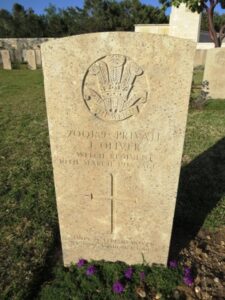
Levi George Owen, Private, 464, Welsh Regiment. Levi was the son of Benjamin and Sarah Owen, of 14, Stepney Terrace, Prendergast, Haverfordwest. He enlisted there into the 1/4th Battalion, Welsh Regiment, which was attached to 159 Brigade, 53rd (Welsh) Division. The 53rd Division moved to the Mediterranean, sailing from Devonport in July 1915 arriving at Mudros by 5 August 1915. From here they moved to Gallipoli, landing on 9 August. Here they immediately faced the chaos that was to lead to the ultimate failure of the campaign, and spent the next few days in isolated pockets, fighting against a Turkish counter-attack during the Battle of Sari Bair, and then at the Attack on Scimitar Hill. Levi was killed two weeks later, on 22 August 1915, aged 21. He is commemorated on the Helles Memorial, Gallipoli.
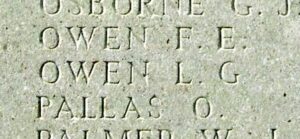
Charles Picton Owens, Engineman, 4846ES, Royal Naval Reserve. Charles was born on 1 March 1890, the son of Thomas and Anne Owens, of 40 Prendergast, Haverfordwest. He was an engineer at Milford Haven prior to the war, and resided with his wife Lilian Owens, at 12 City Road, Haverfordwest. Charles served in the Royal Naval Reserve, aboard H.M. Drifter Active III. Charles died when she was lost at sea on 15 October 1917. He was 27 years old, and is commemorated on the Plymouth Naval Memorial, Devon.
George Edward Phillips, Corporal, 27262, Welsh Regiment. George was the son of John and Maria Phillips, of Rose Cottage, Prendergast, Haverfordwest. He enlisted at Neath into the Welsh Regiment, and served with the 8th Battalion, attached to 40 Brigade, 13th (Western) Division. Towards the end of February the entire Division concentrated at Blackdown in Hampshire. On 7 June 1915 orders were received to prepare to move to the Mediterranean. On 13 June 1915 the first transports carrying the Division left port, and moved to Alexandria. By 4 July, all units had moved to Mudros, preparatory for landing on Gallipoli. Between 6 and 16 July 1915 the Division landed on Cape Helles and relieved the 29th Division. They left and returned to Mudros at the end of the month, and the entire Division landed at ANZAC Cove between 3 and 5 August 1915, taking part in the Battle of Sari Bair, and the Battle of Russell’s Top. George was killed in action here on 8 August 1915, aged 23. He is commemorated on the Helles Memorial, Gallipoli.
Thomas Henry Richards, Private, 265368, Welsh Regiment. Thomas was the son of Essex and Martha Richards, of Rathe Cottage, Rudbaxton, and had served during the war with the 6th Battalion, Welsh Regiment. The battalion had formed for war at Swansea on 4 August 1914, attached to South Wales Brigade, Army Troops. On 29 October 1914 the battalion landed at Havre, where it was used as a Labour Battalion. On 5 July 1915 it transferred to 84 Brigade, 28th Division, then on 23 October to 3 Brigade, 1st Division, where it became the Pioneer Battalion in 1st Division. At the signing of the Armistice on 11 November 1918, the battalion was at La Vallee Mulatre, N.E. of Bohain, and was selected to remain as part of the occupational forces. Thomas was sadly to become the last casualty of war from Rudbaxton. He was one of many men to survive the war only to become ill with influenza. He died on 4 February 1919, aged 25, and is buried at Les Baraques Military Cemetery, Sangatte, France, in Grave Ref. VIII. B. 1.
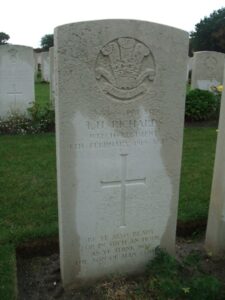
William Roach, Gunner, 46857, Royal Garrison Artillery. William was the son of William and Elizabeth Roach of Poyston Cross, Rudbaxton. He worked as a farm labourer prior to the war and enlisted at Haverfordwest into the Royal Garrison Artillery. William served with the 68th Siege Battery on the Western Front, and was wounded whilst the Battery was on the Somme in August 1916. He was evacuated to the Base Hospital at Abbeville, where he sadly died of his wounds on 19 August 1916, aged 21. William is buried at Abbeville Communal Cemetery, France.
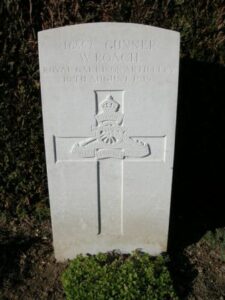
Benjamin James Rodney, Gunner, 30002, Royal Field Artillery. Benjamin was born in 1894, the son of Thomas and Ann Rodney, of Mill Cottage, Prendergast. He worked in the Great Western Railway Station at Llanybydder, and enlisted at Preston into the Royal Field Artillery, being posted to their ‘A’ Battery, 77th Brigade, and landed in France on 21 July 1915. The Brigade was attached to the 16th (Irish) Division, and took part in the famous Battle of Messines, where the Irish and Australians took the Ridge from the Germans. Benjamin died of wounds on 29 July 1917, aged 23, and is buried in Mendinghem Military Cemetery, Belgium. His brother, George Stanley Rodney, also fell.
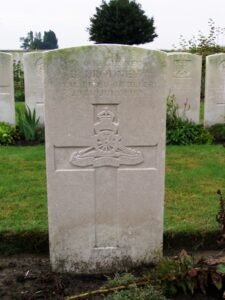
George Stanley Rodney, Gunner, 120940, Royal Field Artillery. George was the son of Thomas and Ann Rodney, of 30 Mill Cottage, Haverfordwest. He enlisted there into the Royal Field Artillery, and served with ‘A’ Battery, 251st Brigade, which was attached to the 50th (Northumbrian) Division. George probably joined his unit on the Somme in 1916, where they fought at the Battle of Flers-Courcelette, the Battle of Morval and the Battle of Le Transloy. After spending a winter on the Somme, they moved north to Arras, where they took part in the Arras Offensive of April, 1917, and fought at the First Battle of the Scarpe, capturing the Wancourt Ridge. They then fought at the Second Battle of the Scarpe, before being sent north again to Ypres. Here they fought at the Second Battle of Passchendaele, and remained here for the winter. During March 1918 they were stationed near St. Quentin, and were hit here by the German Spring Offensive of 21 March 1918 during the Battle of St Quentin. They took part in a gallant rearguard action during the Actions at the Somme Crossings, and then at the Battle of Rosieres. After suffering terrible casualties, the Division moved north to Flanders to rest and rebuild, but in April the Germans launched an attack in Flanders, around the Lys, and the Division took part in the Battle of Estaires, and the Battle of Hazebrouck. Following a most trying time on the Somme and Lys battlefields, the Division was withdrawn and sent to IX Corps, then on the Aisne, believed to be a much quieter area. This was unfortunately not the case, as the Division was hit hard by a surprise enemy attack, and fought at the Battle of the Aisne, 1918. George was killed in action during the Battle of the Aisne, on 27 May 1918. He was 27 years old, and is commemorated on the Soissons Memorial, France. His brother, Benjamin James Rodney, also fell.
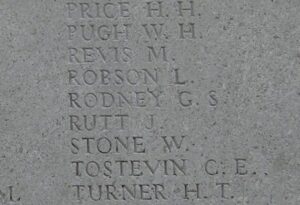
Harold John Thompson, Stoker 1st Class, Royal Navy. Harold was born on 4 May 1896, the son of William Henry and Ann Thompson, of Haverfordwest. He joined the Royal Navy in May 1915, and first served aboard HMS Dartmouth. On 15 May 1917 Dartmouth was damaged by a torpedo, but managed to limp back to port for repairs. Harold then served aboard the Avon Class Destroyer, HMS Bittern. On 4 April 1918, Bittern was involved in a collision with SS Kenilworth off the Isle of Portland in thick fog. The destroyer was overwhelmed and sank quickly with the loss of all hands. Harold was 21 years old, and is commemorated on the Plymouth Naval Memorial, Devon.
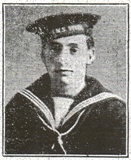
George Edwin Wilson, Private, 51152, Cheshire Regiment. George was born at Kempsey, Worcester in 1895, the son of Charles and Elizabeth Wilson. By 1911 his family had moved to Withybush, and George was residing at Park House, Haverfordwest, working as an agricultural labourer. He enlisted at Swansea on 14 June 1915 into the Army Service Corps, and on 19 May 1916 landed in France with 302 M.T. Company. On 24 September 1917, George was transferred to the 1/6th Battalion, Cheshire Regiment, which was attached to 118 Brigade, 39th Division. The Division had been in France since early March 1916, and had taken part in the Battle of the Somme in the summer of 1916. George joined the battalion at Ypres, and fought during the Battle of Passchendaele. During the beginning of 1918 the division was stationed near St. Quentin, and was one of the Divisions to be hit hard here by the German Offensive which was launched on 21 March 1918. It fought here at the Battle of St Quentin, and took part in desperate fighting on the Somme Crossings and the Battle of Rosieres. George was killed in action during this traumatic period, on 30 March 1918, aged 22. He has no known grave, and is commemorated on the Pozières Memorial, France.
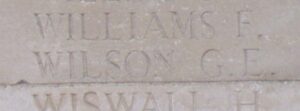
——————————————————————————————————————————————————-
World War Two, 1939-1945
John Henry Adams, Sergeant, 1412902, Royal Air Force Volunteer Reserve. John was the son of George Thomas Adams and Mary Eliza Adams, of Haverfordwest. He served with 37 Squadron, Royal Air Force, which was equipped with the Vickers Wellington, and operated in the Middle East in support of the ground offensive in North Africa. John was killed during the invasion of Italy on 27 January 1944. He is commemorated on the Malta Memorial, Malta.
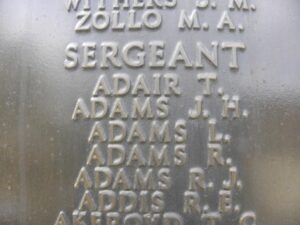
Michael J. Bryant, BEM, Warrant Officer Class I (RSM), 1913949, Royal Engineers. Michael was originally from Cork, the son of Michael and Mary Bryant. He married Mildred Martha Thomas, of Haverfordwest, in 1939. He enlisted on 19 January 1940, and served in France with 684 GC Company, Royal Engineers, before being evacuated from Dunkirk with the BEF. After returning from Dunkirk, Michael was awarded the British Empire Medal for his gallantry after rescuing a man from the wreckage of a bombed house in Scotland. He was then posted to 934 Port Construction and Repair Company, Royal Engineers, and landed back in France on 11 July 1944, his unit being involved in the construction and repair of pontoon bridges. Michael was killed during a road accident in Germany on 18 April 1945. He was 30 years old, and is buried at Reichswald Forest War Cemetery, Germany.
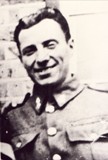
Matthew Bulmer, Corporal, 13062628, Pioneer Corps. Mathew was the son of Matthew and Miriam Bulmer, of Sunderland. He married Alice May Butler, of Prendergast in 1938. Matthew served with the Pioneer Corps. He died on active service in Lincoln on 17 April 1945, aged 29, and is buried at Lincoln (Newport) Cemetery, England.
Frederick Rodney Albert Chalk, Sergeant (Air Gunner), 534048, Royal Air Force. Frederick was the son of Joseph Hiram and Alice Louisa Chalk, of Haverfordwest, and the husband of Doreen Mildred Chalk. He served with 240 Squadron, Royal Air Force, which was a seaplane squadron. In August 1939 it moved to Invergordon and began patrolling the North Sea, and in May 1940 it moved to Pembroke Dock, its area shifting to the Western Approaches, having converted to Short Stranraers in June. Having moved back to Scotland in July 1940, the squadron re-equipped with Consolidated Catalinas in March 1941. Frederick was one of eight men who died when their Catalina, Serial AM265, crashed into a mountain on 21 March 1941. He was 25 years old, and is buried at Irvinestown Church of Ireland Cemetery, Ireland.
Brynmor Edgar Davies, Cadet, Merchant Navy. Brynmor was born in Swansea in 1924, the son of Jean Davies (nee Jenkins). His mother was then widowed and moved back home to Uzmaston soon after Brynmor’s birth, before marrying William Henry Thompson, of 9, Bridgend Square, Haverfordwest, in 1932. Brynmor was educated at Haverfordwest Grammar School before enlisting into the Merchant Navy as a Cadet and was posted aboard the SS Hartington, a London registered cargo vessel. Hartington left Great Britain on 18 September 1942, joining Convoy ONS 134, bound for Halifax Nova Scotia, and arrived in Halifax on 7 October. Twenty days later, Hartington left Halifax in Convoy SC 107, laden with urgent supplies, destined for the United Kingdom. On the night of 2 November 1942, Hartington was the fourth ship of the Convoy to be torpedoed by enemy submarines. Brynmor was lost that night. He was 18 years old, and is commemorated on the Tower Hill Memorial, London.
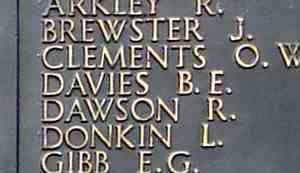
George Devereux Davies, Sergeant (Obs.), 924555, Royal Air Force Volunteer Reserve. George was born in 1914, the son of Austin George Davies and Mary Ann Davies (nee Williams), of 2, Prendergast, Haverfordwest. Upon leaving Haverfordwest Grammar School, he enlisted into the Royal Air Force Volunteer Reserve and was posted to RAF Bicester, in Oxfordshire, to join 13 Operational Training Unit, for training as an Observer. On 17 July 1941, George took off from RAF Bicester aboard a Bristol Blenheim IV, Serial R3805, on a Navigation Exercise. The Blenheim lost both engines whilst circling the airfield and crashed at Shelswell Park, near Cottisford, killing all but one of her crew. George was 27 years old when he died that day. His remains were recovered from the wreckage, and he was brought home for burial in Haverfordwest (Prendergast) Cemetery.
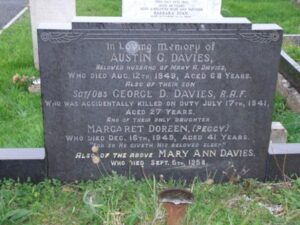
William James Evans, Fusilier, 4198817, The Royal Welch Fusiliers. William was the son of J. S. and Frances Evans, of Haverfordwest, and served with the 1st Battalion, Royal Welch Fusiliers. The battalion fought in the Far East during the war. William was killed in Burma on 18 March 1943. He was 25 years old, and is commemorated on the Rangoon Memorial, Myanmar.
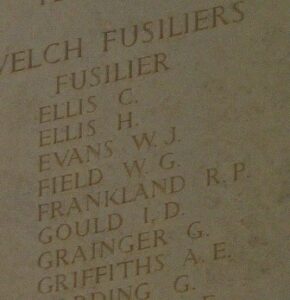
Robert Reginald Mathias, Gunner, 910931, Royal Artillery. Robert was born in 1920, the son of Alfred Mathias and Rose Ellen Mathias (nee Rowlands), of 24, Kensington Road, Neyland. Educated at Haverfordwest Grammar School, he married Florence Doris Holford at Haverfordwest in 1943 and the couple set up home at 3, Church Cottages, Prendergast. Robert by then was already serving with the 102 (The Pembroke Yeomanry) Medium Regiment, Royal Artillery, which was the local Territorial unit. The unit left England and landed at Algiers in February 1943, joining the First Army for the Allied invasion of North Africa (Operation Torch), operating as an Army Field Regiment. It landed at Algiers in February 1942, with one of the first self-propelled 25-pounder (Bishop) batteries to see action. In February 1943 the battery took part in desperate fighting when the 46th Infantry Division was overrun by the Germans, helping force the Germans to withdraw. Following the surrender of the Afrika Korps, the regiment remained in North Africa and was reorganised before moving to Italy in December 1943, to take part in the bloody advance northwards. Robert was killed in Italy on 24 April 1945. During the Allied Spring offensive. The 25-year-old is buried in Argenta Gap War Cemetery, Italy.
William Hubert Ernest Mills, Fireman, Fishing Fleet. William was the son of Mary Annie Mills, of Haverfordwest, and lived at 12, Corporation Road. He was a fisherman, and worked aboard the Fishing Vessel Bass Rock. On 24 September 1940 Bass Rock was fishing off the Old Head of Kinsale, Ireland, when it was attacked and sunk by a German aircraft. William was one of four men killed in the attack. He was 32 years old, and is commemorated on the Tower Hill Memorial, London.
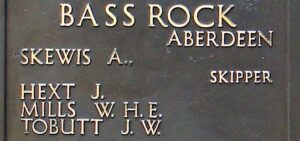
Dyfrig George Morgan, Able Seaman, D/SSX26145, Royal Navy. Dyfrig served aboard H.M.S. Matabele, which was a ‘Tribal’ Class Destroyer, completed on 25 January, 1939. She served in the 6th Destroyer Flotilla, and fought during the battles of Norway in 1940, and on the Arctic Convoys in 1941 and 1942. She saw varied service, being an escort to various Commando landings, and was used for anti submarine duties, as well as convoy escort work. During January, 1942 she was nominated for escort work on Convoy PQ8 to Murmansk, and on 17 January 1942 was hit by a torpedo from the German submarine U-454 and exploded, sinking immediately. Only two men survived. Dyfrig went down with the ship that day, and is remembered on the Plymouth Naval Memorial.
Arthur Phillips, Second Engineer, Fishing Fleet. Arthur lived at 8, Mayoral Terrace, Haverfordwest, and served as an engineer aboard the Fishing Vessel Respondo which was based at Milford Haven. Arthur drowned when Respondo was lost with all hands off the Old Head of Kinsale on 10 September 1940. He was 60 years old, and is commemorated on the Tower Hill Memorial, London. Arthur is commemorated on the Tower Hill Memorial, London.
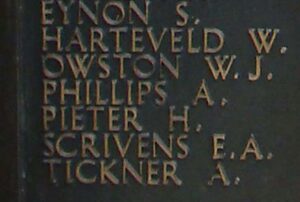
Charles Owen Thomas, Fourth Engineer Officer, Merchant Navy. Charles was the son of Charles Albert Thomas and Mary Dorothy Thomas (nee Phillips), of 12, Wellington Terrace, Haverfordwest. Upon completing his studied at Haverfordwest Grammar School, Charles trained as a Marine Engineer before enlisting into the Merchant Navy and was posted aboard the SS Tregarthen, a London registered vessel. On 24 May 1941 Tregarthen left Cardiff carrying 7,800 tons of coal bound for Kingston, Jamaica. Steaming off Milford Haven she joined Convoy OB 327, which took her out into the Atlantic, before dispersing on 1 June. Just before midnight on 6 June 1941, Tregarthen was in mid-Atlantic when she was hit in the stern by two torpedoes which had been fired by the German submarine U-48, and within three minutes capsized and sank, with the loss of all 45 men aboard. Charles was 22 years old when he was killed that night, and is commemorated on the Tower Hill Memorial, London.

Ivor George Thomas, Private, 4202154, The Gloucestershire Regiment. Ivor was the son of Charles and Lucy Thomas, and the husband of Lilian Lydia Thomas, of Prendergast. He initially enlisted into the Royal Welch Fusiliers, then served with the 1st Battalion, Gloucestershire Regiment, which saw active service in Burma against the invading Japanese forces. Ivor was killed in Burma on 1 May 1942. He was 28 years old, and is commemorated on the Rangoon Memorial, Myanmar.
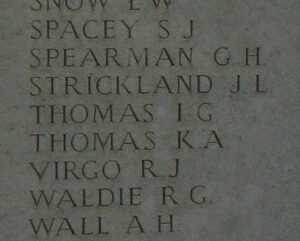
James Thomas George Williams, Guardsman, 2614943, Grenadier Guards. James was the son of Thomas George and Rose Williams, of Prendergast, Haverfordwest. He served with the 3rd Battalion, Grenadier Guards. James was killed during the withdrawal to Dunkirk on 31 May 1940, probably while attached to the 1st or 2nd Grenadier Guards. He was 25 years old, and is commemorated on the Dunkirk Memorial, France.
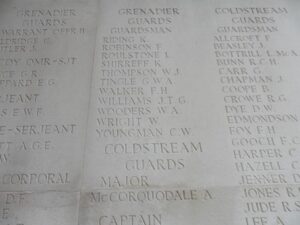
William Bernard Williams, Private, 5575773, The Wiltshire Regt (Duke Of Edinburgh’s). William was the son of David and Jane Williams, of Haverfordwest, and served with the 1st Battalion, Wiltshire Regiment. The battalion fought in India during the war, and helped in the evacuation of Burma. William was 30 years old when he died in India on 8 May 1942. He is buried at Delhi War Cemetery, India.
William Ernest Williams, Able Seaman, D/SSX 16110, Royal Navy. William was the son of David and Maud Williams, of Prendergast, and served with the Royal Navy aboard the aircraft carrier HMS Glorious. Glorious had been one of the first aircraft carriers in the world, after being converted from a Great War cruiser, and had seen service in the Mediterranean by the outbreak of World War 2. She was recalled to home waters to support the British during the German invasion of Norway in 1940, but was attacked and sank by the German battleships Scharnhorst and Gneisenau while returning to Scapa Flow on 8 June 1940, after Norway had fallen. William was among 1,500 men of Glorious who either died in the sinking. He was 24 years old, and is commemorated on the Plymouth Naval Memorial, Devon.
Frank George Wood, Private, 925736, The South Wales Borderers. Frank was the son of Mr. and Mrs. George Wood, of Haverfordwest, and served with the 6th Battalion, South Wales Borderers. The battalion was raised in July 1940, and sailed for Bombay in October 1942. They fought during the Burma campaign for the remainder of the war. Frank died in Burma on 19 December 1944. He was 22 years old, and is buried at Digboi War Cemetery, India.
Burma Star Association Plaque
